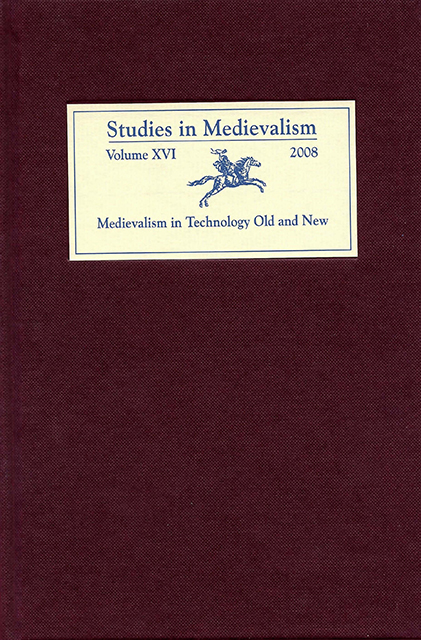Book contents
- Frontmatter
- Studies in Medievalism
- Acknowledgments
- Contents
- Volume XVI 2008
- Illustrations
- Editorial Note
- Contes du Style des Troubadours: The Memory of the Medieval in Seventeenth-Century French Fairy Tales
- A Ritual Failure: The Eglinton Tournament, the Victorian Medieval Revival, and Victorian Ritual Culture
- An Eastern Medieval Revival: Byzantine Art and Nineteenth-Century French Painting
- I Am Weary of That Foolish Tale: Yeatss Revision of Tennysons Idylls and Ideals in Time and the Witch Vivien
- The Doughboy Comes to Chartres: Stars and Stripes and the Middle Ages
- Constructing Difference: The Guidonian Hand and the Musical Space of Historical Others
- An Introduction to Medievalist Video Games
- Medieval and Pseudo-Medieval Elements in Computer Role-Playing Games: Use and Interactivity
- Romancing the Game: Magic, Writing, and the Feminine in Neverwinter Nights
- Revising the Future: The Medieval Self and the Sovereign Ethics of Empire in Star Wars: Knights of the Old Republic
- Promises of Monsters: The Rethinking of Gender in MMORPGs
- Contributors
Romancing the Game: Magic, Writing, and the Feminine in Neverwinter Nights
Published online by Cambridge University Press: 10 March 2023
- Frontmatter
- Studies in Medievalism
- Acknowledgments
- Contents
- Volume XVI 2008
- Illustrations
- Editorial Note
- Contes du Style des Troubadours: The Memory of the Medieval in Seventeenth-Century French Fairy Tales
- A Ritual Failure: The Eglinton Tournament, the Victorian Medieval Revival, and Victorian Ritual Culture
- An Eastern Medieval Revival: Byzantine Art and Nineteenth-Century French Painting
- I Am Weary of That Foolish Tale: Yeatss Revision of Tennysons Idylls and Ideals in Time and the Witch Vivien
- The Doughboy Comes to Chartres: Stars and Stripes and the Middle Ages
- Constructing Difference: The Guidonian Hand and the Musical Space of Historical Others
- An Introduction to Medievalist Video Games
- Medieval and Pseudo-Medieval Elements in Computer Role-Playing Games: Use and Interactivity
- Romancing the Game: Magic, Writing, and the Feminine in Neverwinter Nights
- Revising the Future: The Medieval Self and the Sovereign Ethics of Empire in Star Wars: Knights of the Old Republic
- Promises of Monsters: The Rethinking of Gender in MMORPGs
- Contributors
Summary
“[…] tell him I feare hym nat whyle I can make me and myne in lyknesse of stonys, and lette hym wete I can do much more when I se my tyme.”
(Morgan le Fay, in Malory's Morte Darthur)Feminist criticism of video games often focuses on their function as a sexist medium, one designed to allow teenage boys to fulfil fantasies of violent empowerment. A majority of the characters with whom the video-game player can identify are male, and when female characters do exist, their avatars are usually hyper-sexualized fantasies of the feminine physique, with a breast-to-waist ratio that would topple any human woman forced to stomp around in the stiletto-heeled boots of her digital sisters. However, now that more female players have emerged as consumers, reviewers, and even designers of video games, companies have begun to reconsider their target market, and they are consequently beginning to add female non-player characters to game plots, create extensive portrait choices and avatars for female players, and construct complex storylines complete with romantic interludes, many of which are geared toward a female audience. The intrusion of the feminine into the landscape of imagined digital masculinity is not limited to the addition of these superficial features. Changes are also occurring on the deep structural level of games, particularly video games that take place within “medieval” environments. These games have evolved markedly from linear, combat-oriented plots characteristic of games like the original versions of Warcraft, Diablo, and Dungeon Siege to the free-ranging, creative, and sprawling magical environments of Neverwinter Nights, Baldur's Gate II, Dungeons and Dragons Online, and World of Warcraft. In other words, as game designers expand their products to embrace their growing female audience, games themselves are undergoing a significant shift in genre, evolving from male-oriented epics into female-friendly romances.
The shift in game genre that accompanies the increasing financial power of female consumers echoes a similar shift in medieval literary genres – one that began over 800 years ago, as some medieval poets also abandoned epic in favor of romance. In twelfth-century France, for instance, poets were increasingly sponsored by and writing for female patrons – patrons who either indirectly (through their financial sponsorship) or overtly encouraged the development of tales told for women.
- Type
- Chapter
- Information
- Studies in Medievalism XVIMedievalism in Technology Old and New, pp. 143 - 158Publisher: Boydell & BrewerPrint publication year: 2008
- 1
- Cited by



